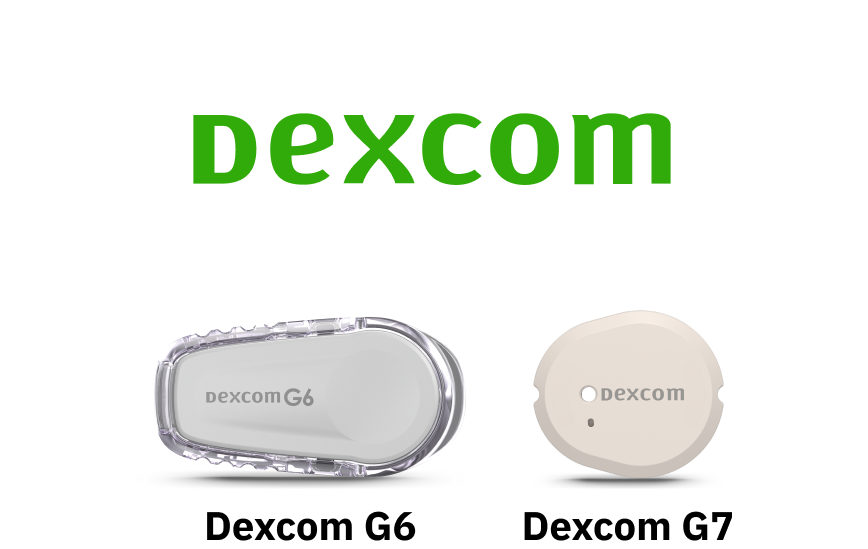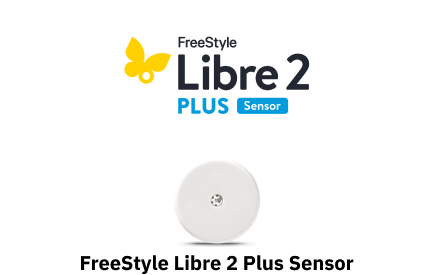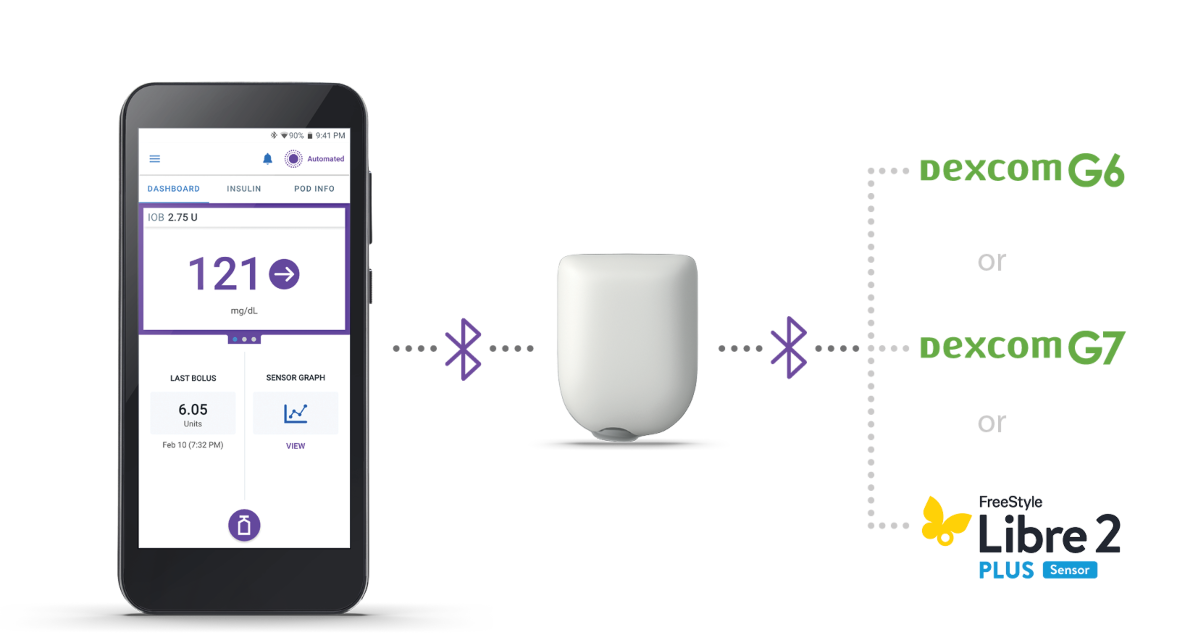Continuous Glucose Monitoring (CGM) for Diabetes
Continuous glucose monitors (CGM) are small wearable devices that allow people with diabetes to monitor glucose levels without using a blood glucose monitor.
CGMs have revolutionized diabetes management because the large amount of data they provide gives you a much clearer picture of glucose levels.
What is a continuous glucose
monitor?1
ADA 2025 Standards of Care1 recommends Continuing Glucose Monitoring (CGM) for diabetes management for those on any type of insulin therapy as they can help achieve glycemic goals. In those with type 1 diabetes, CGM use has been shown to reduce A1c levels, improve time in range and decrease episodes of hypoglycemia. In type 2 diabetes, CGM use has been shown to reduce A1c levels and improve time in range.
Continuous glucose monitors allow users to know their glucose levels without the burden of frequent fingerstick* testing.
A continuous glucose monitor provides hundreds of real-time glucose readings per day, wirelessly sent to your phone or a separate receiver, which gives you real time insights into how the body is responding to insulin, food and daily activity. Results over time, can help people determine if their glycemic goals are being achieved, and if changes need to be made to their diabetes management.
CGM devices can generally be worn when bathing, showering, or swimming but always check with the different manufacturer’s recommendations. The sensor must be replaced every 6 to 15 days depending on the system. This is carried out by the user or their caregiver.
How does CGM work?
A CGM system involves three parts:
- The sensor: sticks to the body using an adhesive patch, with a thin filament inserted under the skin. Every few minutes it takes a reading from ‘interstitial fluid’, which is different from the glucose reading taken via a blood drop from the finger.
- The transmitter: can be clipped onto the sensor or is built into the sensor. It communicates the reading wirelessly to the display device.
- The smartphone app or receiver (display device): where you can easily view your current glucose reading and track the direction of your glucose levels, as well as trends over time.
You may still need to occasionally do a fingerstick, for example, if what you’re feeling doesn’t match what your reading says or if you want to double check before treating a high or low sensor reading.
This is why it’s important that you still get your blood glucose meter, to allow you to do fingersticks.
CGM readings can lag behind the current blood glucose levels, and therefore readings can differ from a blood glucose meter value, especially if glucose levels are falling or rising rapidly.
What’s the difference between a flash glucose sensor and a continuous glucose monitor?1
A CGM is a real-time continuous glucose monitor (rtCGM), while a Flash Glucose Sensor is what’s called an intermittently-scanned continuous glucose monitor (isCGM).1
With an isCGM or flash glucose monitor, you need to wave (or scan) a device over the sensor to get the glucose reading. The information is not automatically transmitted. The scan/wave can be done over clothes, including thick clothing like coats.
Real-time CGM, as it’s defined, automatically transmits the readings in real time, via Bluetooth, to a receiver or smartphone every few minutes without any need for scanning. Real-time CGMs are an essential part of Automated Insulin Delivery (AID) or Hybrid Closed Loop (HCL) Systems, like Omnipod® 5. The CGM values are required for the systems to adjust insulin delivery.
Real-time CGM or intermittently-scanned CGMs are recommended for diabetes management to youth and adults with diabetes on any type of insulin therapy.1




Key benefits of continuous glucose monitors
Lifestyle benefits
- You can check your glucose levels very quickly, on the move.
- Data shows clearly and easily whether glucose levels are high, low or in range.
- In addition, trend arrows show whether glucose levels are rising, falling, or stable.
- Some sensors can even send this data to a smartwatch for convenience.
- The data can also be sent to another device, for example a parent or partner’s phone, or your healthcare team ahead of your appointments.
- Many sensors use alarms to alert you when your blood glucose is too high or too low. This can be particularly useful for those worried about lows at night.
Clinical Benefits1
- Reduced A1c for those with both type 1 and type 2 diabetes.
- Improved time in range (70-180mg/dL) for those with both type 1 and type 2 diabetes.
- Reduces episodes of lows (hypoglycemia) for those with type 1 diabetes.
- The large quantities of data can help to spot patterns in glucose behavior, like rising quickly after certain foods, at certain times of the day or during exercise.
How does CGM help with diabetes management?
The glucose information and trends give someone living with diabetes a greater picture of what their glucose levels are doing at any given time of the day.
This information can be used to help inform treatment decisions, - for example, when waking, eating, or during exercise.
Some sensors will also alert you when your glucose is running high or low, or even predict hypoglycemia in advance. This feature can help give greater peace of mind when it comes to hypoglycemia or hyperglycemia.
Research suggests that continuous glucose monitoring can help people with type 1 diabetes improve their time in range, as well as reducing their HbA1c without increasing the risk of hypoglycemia. In type 2 diabetes, CGM use has been shown to reduce A1c levels and improve time in range.1
Can I use a glucose monitor alongside a Pump?
The short answer is yes. In fact, 2025 ADA Standards of Care recommend that insulin pump therapy, preferably with CGM, should be offered for diabetes management to youth and adults on multiple daily injections (MDI). And AID systems, where a CGM is a required component, should be the preferred insulin delivery method for those with type 1, and any other types of insulin-deficient diabetes.1
The Omnipod 5 System currently is compatible and works with Dexcom G6, Dexcom G7 and the FreeStyle Libre 2 Plus Sensor to enable Automated Insulin Delivery (AID).
Real-time CGMs are an essential part of Automated Insulin Delivery (AID) or Hybrid Closed Loop (HCL) Systems, like Omnipod 5.
The glucose readings from the rtCGM are sent wirelessly to the pump or Pod, where an algorithm automatically adjusts insulin based on the glucose readings and trend, and delivers the automated insulin according to your personal needs.* This may help to control blood glucose levels, reduce hypoglycemia, and increase time in range.1 We will cover this in much more detail on our What is Automated Insulin Delivery page.


Is Omnipod 5 right for me?
Find out more about the Omnipod 5 Automated Insulin Delivery System and how it works together with a compatible sensor to incorporate your glucose data and trends to automatically adjust insulin delivery.
Frequently Asked Questions about CGMs
How does a continuous glucose monitor differ from using a blood glucose meter?
How often do you have to change a flash or CGM sensor?
Where can I wear a flash or CGM sensor?
Can I share my glucose data with friends and family?
What is the Omnipod 5 Automated Insulin Delivery System?
Continue reading:
Related Articles
Other topics
References and Disclaimers
1- American Diabetes Association Professional Practice Committee; 7. Diabetes Technology: Standards of Care in Diabetes—2025. Diabetes Care 1 January 2025; 48 (Supplement_1): S146–S166. https://doi.org/10.2337/dc25-S007
These articles are not a replacement for medical advice or training. Please always speak to a qualified healthcare professional about your options.
The information and other content provided in this article, or in any linked materials, are not intended and should not be construed as medical advice, nor is the information a substitute for professional medical expertise or treatment. If you or any other person has a medical question or concern, you should consult with your healthcare provider. Never disregard professional medical advice or delay in seeking it because of something that have read on this blog or in any linked materials. If you think you may have a medical emergency, call your doctor or emergency services immediately. The opinions and views expressed on this blog and website have no relation to those of any academic, hospital, health practice or other institution.
The Omnipod® 5 Automated Insulin Delivery System is indicated for use by individuals with type 1 diabetes mellitus in persons 2 years of age and older and type 2 diabetes mellitus in persons 18 years of age and older. The Omnipod 5 System is intended for single patient, home use and requires a prescription. The Omnipod 5 System is compatible with the following U-100 insulins: NovoLog®, Humalog®, and Admelog®.
Available products subject to current insurance coverage and product indication for use. Insulet can only support onboarding for those customers within the product indication.
Refer to the Omnipod 5 Automated Insulin Delivery System User Guide and www.omnipod.com/safety for complete safety information including indications, contraindications, warnings, cautions, and instructions. Warning: DO NOT start to use the Omnipod 5 System or change settings without adequate training and guidance from a healthcare provider. Initiating and adjusting settings incorrectly can result in over-delivery or under-delivery of insulin, which could lead to hypoglycemia or hyperglycemia.



